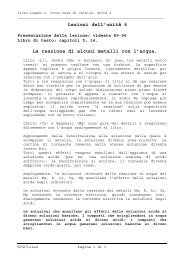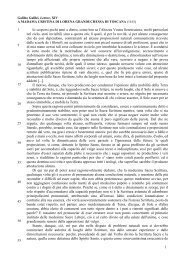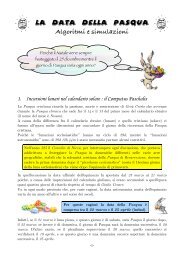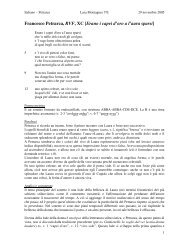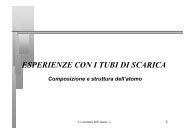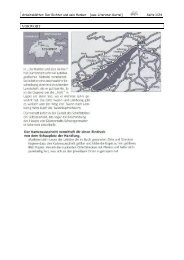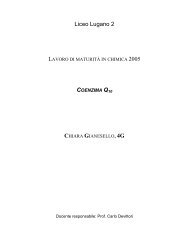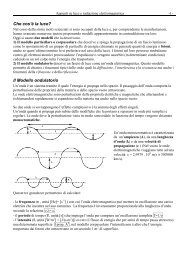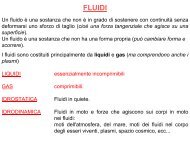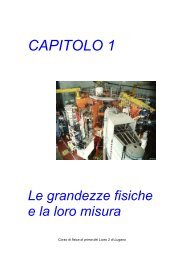The Other Double HelixâThe Fascinating ... - ZyXEL NSA210
The Other Double HelixâThe Fascinating ... - ZyXEL NSA210
The Other Double HelixâThe Fascinating ... - ZyXEL NSA210
- No tags were found...
Create successful ePaper yourself
Turn your PDF publications into a flip-book with our unique Google optimized e-Paper software.
Chemistry for Everyone<strong>The</strong> <strong>Other</strong> <strong>Double</strong> Helix—<strong>The</strong> <strong>Fascinating</strong> Chemistry of StarchRobert D. Hancock* and Bryon J. TarbetResearch Department, Power Engineering, 364 West 600 North, Salt Lake City, UT 84301; *griboux@aol.comOrganic chemistry texts usually give a description of thechemistry of starch limited to a paragraph or two stating thatit is an α-(1→4) linked polymer of glucose and that there aretwo components present (1–3). <strong>The</strong> two components are statedto be amylose and amylopectin, the former being a linearpolymer comprising about 20% of the starch by weight, whileamylopectin is a branched polymer with frequent α-(1→6)branching points, comprising about 80% of starch. <strong>The</strong> textmay point out that amylopectin is a large molecule with amolecular mass of about 10 9 Da, whereas amylose is muchsmaller with a molecular mass of about 10 6 Da. <strong>The</strong> helicalstructure of starch is sometimes briefly mentioned. This brevityis no doubt due to the need to keep textbooks to a reasonablelength, but it leaves out the connection of chemistry to everydayphenomena that makes a subject such as organic chemistrycome alive for students.<strong>The</strong> chemistry of starch is fascinating for at least threereasons, apart from the fact that starch is the most abundantbiomolecule on earth after cellulose and forms a major part ofthe diet of all human beings. We present this chemistry herein the hope that teachers of organic chemistry will find thisarticle useful as a source for material to make their organicchemistry courses more relevant and interesting, and that someof this information will find its way into future textbooks.<strong>The</strong> first point of interest in starch chemistry is thestructure of the starch granule itself, which is the form inwhich starch is laid down by plants as a means of storage.<strong>The</strong> branching of amylopectin is not an arbitrary feature, butis a necessary aspect of the way in which plants lay downstarch in granules in a remarkable partly crystalline form thatallows for efficient packing of the starch in the granule. <strong>The</strong>second point of interest in starch chemistry relates to themolecular-recognition properties of starch itself, the mostfamiliar example being the absorption of iodine from aqueoussolution to give the blue color of the test for starch. <strong>The</strong> thirdpoint of interest is the swelling of the starch granule on heatingin water above what is known as the gelatinization point, typicallyabout 60 °C. Starch granules can increase in volume by afactor of as much as 100 on gelatinization, and this propertyof swelling together with the molecular-recognition propertiesof starch are key features in the cooking of foods involvingstarches.<strong>The</strong> Structure of Starch and Starch GranulesA helical structure for starch was proposed in 1937 (4),long before the helical structure for DNA. Crystallographicevidence for such a structure was reported as early as 1943 (5).More recent crystallographic studies show that starch occurs inthree allomorphs, known as the A, B, and V forms (6–10).<strong>The</strong> A and B forms both have left-handed double helices,with six glucose units per turn. <strong>The</strong> A and B forms appear todiffer only in the packing of the starch helices, the A formhaving a monoclinic unit cell, space group B2 (6 ), and the Bform having a hexagonal unit cell, space group P6 1 (7). <strong>The</strong>V form is actually a whole family of allomorphs, adopted in thepresence of internally absorbed small molecules such as iodine,DMSO, or n-butanol (9, 10). All of the V forms have a singlehelixstructure, also left-handed, with approximately an 8-Ådrop per 6 glucose units that constitute one turn of the helix.Figure 1. (a) <strong>The</strong> structure of maltose, showing the torsion angles(curved arrows) across the glycosidic bond holding the two glucoseunits together (6, 7). If a series of glucose units is connected maintainingthese torsion angles across the glycosidic bonds, a lefthandedhelix is obtained. (b) Two helices entwined give the doublehelix of A-type or B-type starch shown here. Each diamond representsa glucose unit. (c) A portion of the A-type or B-type starch doublehelix, which we generated using molecular mechanics modeling.Each strand is 8 glucose units long. One strand has been colored auniform dark gray to distinguish it from the other. <strong>The</strong> black atoms inthe light strand are oxygen atoms, the large light gray atoms arecarbons, and the small near-white atoms are hydrogens. (d) <strong>The</strong>packing of starch helices in crystalline B-type starch, viewed alongthe long axes of the helices (7 ) (redrawn after ref 9). <strong>The</strong> centralcavity of each helix is too small to accommodate water molecules.<strong>The</strong> large “water channels”, each surrounded by six starch helices,are filled to a variable extent with water molecules (not shown).988 Journal of Chemical Education • Vol. 77 No. 8 August 2000 • JChemEd.chem.wisc.edu
Chemistry for EveryoneIt is of interest to note that, although we have referredto starch as “the other double helix”, starch and DNA are notthe only biomolecules with double-helical structures. At leasttwo other polysaccharides, hyaluronic acid and carrageenan,have double helices (11, 12). Hyaluronic acid is a mucopolysaccharidethat occurs in places such as amniotic fluid andthe vitreous humor of the eye (11). Carrageenan occurs inred algae (12). A triple helix is found in collagen, the proteinfound in skin, connective tissue, and bones (13).Starch granules show birefringence under polarized light,indicative of long-range internal order. Starch granules givedistinctive X-ray diffraction patterns that can be analyzed toelucidate the crystalline structure within. <strong>The</strong> double-helixstructure of type A and B starch is shown in Figure 1. <strong>The</strong>double helix arises directly from the preferred orientation oftwo adjacent glucose molecules connected by an α-(1→4)glycosidic linkage (6, 7), which is well illustrated by maltose(Fig. 1). Maltose consists of two α-(1→4) connected glucoseunits, and experimentation with molecular mechanicsmodeling programs (6, 7) shows that there is a strong energyminimum with the O1–C1–O4′–C4′ and C1–O4′–C4′–C5′torsion angles (Fig. 1) having values of 83.8 and 144.6°,respectively. If one continues to build the model connectingglucose units in an α-(1→4) fashion and maintaining thesetorsion angles, one obtains one strand of the starch doublehelix. It is thus remarkable that the structure of the starchhelix is implicit in the preferred torsion angles across theglycosidic linkage of adjacent glucose units connected in anα-(1→4) fashion. In the A and B forms of starch the helixhas the hydroxymethyl groups of C6 oriented somewhat intothe central cavity, and the planes of the glucose units areoriented at a considerable angle to the long axis of the helix.<strong>The</strong> orientation of the glucose units relative to the axis ofthe double helix is apparent in Figure 1d. <strong>The</strong> hydroxylgroups on C6 form hydrogen bonds to the O2 hydroxyls onthe other strand of the double helix, which hold the twostrands of the double helix together. <strong>The</strong> orientation of theC6 hydroxymethyl group into the central cavity of the helixmeans that the central cavity of the A and B forms of starchis too small to accommodate molecules (7) (Fig. 2, right).In contrast, the V form has the planes of the rings of theglucose units aligned more nearly in the wall of the helix (10)(Fig. 2, left), and has a larger central cavity that is largelyhydrophobic. <strong>The</strong> hydrophobic surfaces of the V-type starchhelix arise from the fact that the hydroxyl groups of the glucoseunits all lie nearly in the plane of the ring (Fig. 2). <strong>The</strong>regions of the glucose units above and below the plane ofthe ring thus consist of C–H bonds, which give the starch itshydrophobic surface. It is this hydrophobic central cavity ofthe V form that gives starch its ability to absorb small linearhydrophobic molecules or hydrophobic parts of molecules.<strong>The</strong> left part of Figure 2 shows a small linear alkane in thecavity of the V form of starch.<strong>The</strong> helical structures are the stable forms of starch in thesolid state below the gelatinization temperature, which isnormally about 60 °C. Above this temperature in water thehelix largely unravels, and the now more-exposed hydrogenbondinghydroxyl groups of the glucose units form hydrogenbonds to the solvent water, leading to the formation of a gel.On standing, a starch gel will slowly return to a helical foldedstructure and deposit flocculated particles of starch.Starch granules have shapes typical of the plants that producethem. <strong>The</strong> largest granules are found in potato tubers,and may be 100 µm along the long axis. In contrast, starchgranules in wheat are smaller, about 30 µm across. <strong>The</strong> starchgranules from potatoes are elliptical, as seen in Figure 3. Micro-Figure 2. Left: one turn of the type V form of starch, viewed down theaxis of the helix. Note how the planes of the rings of the glucoseunits are more nearly aligned with the axis of the helix, creatinga central cavity with an internal diameter of about 4 Å. A shortn-alkane has been placed in the central cavity to show the good fit,which leads to the ability of starch to absorb small linear moleculessuch as iodine, n-butanol, and fats. <strong>The</strong> single turn of the starch helixwas generated with the aid of a computer modeling program, byjoining 6 glucose units using torsion angles about the glycosidiclinkages given in ref 9. <strong>The</strong> darker large atoms are oxygens, the lighterlarge atoms are carbons, and the small light atoms are hydrogens.<strong>The</strong> carbons nearest the observer are the C6 carbons of the glucosering. <strong>The</strong> hydroxyls on the C6 carbons hydrogen-bond to those onthe C2 carbon atoms of the glucose units in the next turn of the helix.Right: a view down the axis of the helix of type A or type B starch,generated as described for Fig. 1. <strong>The</strong>re is insufficient space in thecentral cavity of the helix even for molecules as small as water (7, 8).Figure 3. Left: drawing of a potato starch granule, showing thelayered structure of alternating crystalline and noncrystalline growthrings. Also shown is the way in which a single amylopectin moleculeextends from the hilum to the surface of the granule. Right: enlargementof the layered structure shows the presence of crystalline andnoncrystalline growth rings. <strong>The</strong> crystalline growth rings are subdividedinto concentric layers of alternating crystalline and noncrystallinelamellae. <strong>The</strong> crystalline lamellae contain linear helical sectionsof amylopectin, whereas the noncrystalline layers contain α-(1→6)branching of the amylopectin. It is the branching in the noncrystallineor amorphous zones that increases the width of the amylopectinmolecule and gives it the wedge shape necessary for efficient packing.<strong>The</strong> amorphous zones of the granule are more susceptible toattack by enzymes such as amylases.JChemEd.chem.wisc.edu • Vol. 77 No. 8 August 2000 • Journal of Chemical Education 989
Chemistry for Everyonescopically, starch granules have a layered structure, resemblingthat of an onion. This structure reflects the laying down ofalternating layers of crystalline and noncrystalline starch (8)(Fig. 3). <strong>The</strong> point of origin of the starch granule is knownas the hilum, and it is from this point that the amylopectinmolecules grow. <strong>The</strong> amylopectin molecules thus extend allthe way from the hilum to the surface of the starch granule,accounting for the large size of these molecules.<strong>The</strong> packing of molecules growing from a central point toproduce a roughly spherical granule will be most efficient ifthese have an approximate wedge shape in cross section. Toachieve this shape the growing amylopectin molecules undergoalternating linear and branching growth to give crystalline andnoncrystalline growth rings. This is achieved in the amyloplastswhere the granules are formed by alternately usingdifferent enzymes that produce either linear or branchinggrowth. Thus at any one time, all the amylopectin moleculesin the same starch granule are undergoing either branchedgrowth or linear growth. It is the layers of branching growthin the amylopectin that periodically increase the width ofthe molecule and produce the wedge shape. At very highmagnification the crystalline growth rings can be seen to havelayers (lamellae) within them, which are thought to reflect adaily cycle of growth (14).<strong>The</strong> role of amylose may be simply that of a packingmaterial, filling in gaps in the structure of the growinggranule. It is interesting that in peas, a mutation in an enzymethat lays down starch, known as the r mutation, leads to awrinkled appearance in the pea (hence r from Latin rugosis,rough) (15). <strong>The</strong> mutation is thought to have occurred inpeas around the year 1600. <strong>The</strong> pattern of occurrence of thismutation in successive generations was one of the inheritableproperties of peas that Mendel studied, which allowed himto deduce the laws of genetics. <strong>The</strong> inefficient enzyme presentwith the r mutation leads to a high amount of amylose and asurplus of unpolymerized glucose in the pea, and a sweeter taste.Peas with the r mutation are preferred for the frozen foodmarket because of their superior taste and freezing properties.disposition of the starch during the swelling process. <strong>The</strong>swelling process is very rapid—too rapid to be effectivelyfollowed by eye under a microscope. Yet the swollen granulehas some mechanical strength (16 ) and appears to have sometype of membrane enclosing the starch gel. If the source ofheat is removed during the swelling process and the granulesare observed microscopically, one sees many granules with theirswelling arrested at various stages (R. Hancock and B. Tarbet,unpublished work). Figure 4 shows a sequence of events inthe swelling of potato starch granules, reconstructed fromgranules observed arrested in different stages of swelling. Atthe onset of swelling, one sees radial cracks originating at thehilum. Coincident with the appearance of these radial cracks,birefringence is lost, and soon thereafter the layered appearanceof the granules disappears. As the granule swells furtherthe hilum gives way to a growing cavity, into which extendtendrils that are clumps of amylopectin molecules, or possiblyeven individual amylopectin molecules. <strong>The</strong>se have been forcedapart by the stress generated by the lateral swelling of the outerlayers of the granule as hot water diffuses inward. As swellingproceeds the cavity enlarges, and the tendrils shorten andfinally disappear as they too become swollen.<strong>The</strong> Swelling and Gelatinization of Starch GranulesAt room temperature starch normally contains about20% by weight of water, which occupies the water channel(Fig. 1d). When starch granules are suspended in water andwarmed below the gelatinization temperature of about 60 °C,more water reversibly enters the starch structure. One canthus observe a decrease in volume when a suspension of starchis warmed. Water enters the noncrystalline layers of starchmore readily than the crystalline layers, and much of thewater uptake of starch below the gelatinization temperatureprobably involves these noncrystalline layers. Above thegelatinization temperature the helix unwinds and becomessolvated forming a gel.<strong>The</strong> process of the swelling of starch granules has somepuzzling features. One is that the X-ray diffraction patternindicating crystalline structure within the granule persists evenas the granule becomes extensively swollen, and only disappearsentirely near the very end of the swelling process (8).It seems strange that a crystalline structure could persist whilethe granule imbibes large quantities of water and swells to asmuch as 100 times its unswollen size. Another puzzle is theFigure 4. Drawings of the process of swelling of a potato starchgranule in hot water. (a) An unswollen starch granule. (b) A granuleat the onset of swelling with cracks radiating out from the hilum.<strong>The</strong> cracks are caused by stress produced by expansion of the outerlayers of the granule and follow the lines of packing together ofamylopectin molecules. (c) <strong>The</strong> hilum has given way to an expandingcavity, and the expanding outer layers of the granule have causedfurther separation of the amylopectin molecules or clumps of moleculesalong the lines of growth radiating out from the hilum. (d) <strong>The</strong> processof expansion of the central cavity of the swelling granule has extendedfurther, and the tendrils of the swelling amylopectin molecules arebeginning to disappear. (e) <strong>The</strong> process of swelling is almost complete;only small conical structures on the inner wall indicate survivingtips of the still swelling amylopectin molecules. <strong>The</strong> Gram–I 2 stain stainsthe outer “membrane” pink, suggesting that it is predominantly amylopectin,whereas the contents of the inner cavity stain blue, suggestingthat this is a gel predominantly of amylose.990 Journal of Chemical Education • Vol. 77 No. 8 August 2000 • JChemEd.chem.wisc.edu
Chemistry for EveryoneIt is possible that the persistence of crystalline structure inthe swelling starch granules reflects the survival of microdomainsof crystallinity within the granules (14). Anotherpossibility is that the production of an X-ray diffraction patternis limited to the nonswollen tendrils of starch extending intothe cavity of the swelling starch granule. As discussed below,it is only amylose that absorbs I 2 strongly and gives a deepblue color (17). <strong>The</strong> branching of the amylopectin approximatelyevery 20 glucose units interrupts the linear array of I 2molecules, which are held together by van der Waals forces.Thus I 2 is much more weakly absorbed by amylopectin thanby amylose and gives a much less intense pink color, whichis usually masked by the intense blue of the amylose–I 2complex. With I 2 , the outer membrane of the swollen starchgranule stains pink and is thus largely amylopectin, whereasthe central cavity stains dark blue and is thus an amylose gel(R. Hancock and B. Tarbet, unpublished work). Mechanicalagitation of a suspension of swollen starch granules leadsto their rupture and the breakup of the outer membrane ofamylopectin. Extended agitation leads to breakup of theamylopectin into smaller polymers called dextrins, and aconsiderable decrease in the viscosity of the gel.<strong>The</strong> art of cooking is heavily dependent on the phenomenonof swelling and gelatinization of starch. When breadand cakes and pastries are cooked, the starch is gelatinized.With time, the starch slowly reorganizes itself into a helicalstructure, at which point the bread is stale, and the process isknown as staling or retrogradation. Presumably when the helicalstructure is reformed, the starch is less prone to attack byamylases in the mouth and so seems tasteless because sugarsare not released. <strong>The</strong> helix also imparts greater rigidity to thestarch, leading to the hardness of stale bread. Above 60 °C thegelatinized form of starch is the stable form, so that staling willnot occur—although other problems with preserving foodat this temperature arise. As the temperature is decreased therate of staling increases until it reaches a maximum at about2 °C. Below this temperature the rate decreases again, andbread can be kept fresh in the freezer at about 10 °C. <strong>The</strong>rate of staling is close to maximum at the temperature of themain part of the refrigerator, so bread will not keep as wellthere as in the freezer compartment or at room temperature.Enclosing bread in a plastic bag retards the rate of water loss,and so of staling. Making toast with somewhat stale breadwill unwind the helix and make the bread taste better, providedthere is sufficient water left for gelatinization to occur.A great deal of ingenuity has been devoted to preventingthe re-formation of the helix in cooked starch products, andso of their staling. <strong>The</strong> prevention of re-coiling of the starchhelix is particularly important in the manufacture of frozenfoods. On coiling of the starch helix, hydrogen-bonded water isexpelled, which leads to “weeping” when the frozen food isthawed. Products for the frozen food market should notundergo retrogradation, which makes them weep as water isexpelled when they are defrosted (i.e., they should be “freeze–thaw resistant”). Food chemists have employed the kinds oftactics that would occur to chemists in general to preventretrogradation of cooked starch. Principally this comes down tosteric hindrance to prevent retrogradation in starches modifiedfor food purposes. Two types of strategy have been employedin modified food starches (18). One is to cross-link the starchas adipate or phosphate diesters (left-hand structure below).<strong>The</strong> other is to place bulky groups on the hydroxyl groupsof the starch, which can be done with the formation of acetates,hydroxypropyl ethers (right-hand structure below),phosphate monoesters, or octenyl succinate half-esters.OOHOHOOOOOOOPOHOO −OOOObridgingphosphatediesterOHObulkyhydroxypropyletherOne can also both cross-link and place sterically hinderinggroups on the starch, using both types of strategy. Bread andpastries made with modified starches can remain “fresh” formuch longer periods than those prepared with unmodifiedstarches. <strong>The</strong> modified starches also show increased heat, acid,and shear resistance. Note that the branching in amylopectinproduces natural steric hindrance and resistance to staling.That is why “waxy” starches from plants bred to producestarches with > 95% amylopectin show naturally greaterresistance to staling.OHComplexation of Small Molecules by Starch<strong>The</strong> hydrophobic central cavity of the V form of starchallows for the selective absorption (“molecular recognition”)of linear molecules such as I 2 , n-butanol, or fats and phospholipidsthat have linear hydrophobic alkyl chains (Fig. 2, left).<strong>The</strong> absorption of I 2 by starch was discussed above.Controversy has surrounded the structure of starchdissolved in aqueous solution (18). One extreme possibilityis that the starch has a random coil structure, which meansthat there are no regions of the polymer that maintain thehelical structure. <strong>The</strong> other extreme possibility is that thestarch is all in its helical form. <strong>The</strong> rate of absorption of I 2by dissolved starch is diffusion controlled, right up to thepoint of loading of the starch to its maximum capacity (19).Since coiling of a randomly structured polymer of starch is notexpected to be so fast, the rapid absorption of I 2 suggests thatthe starch already has a largely coiled structure in solution.Studies of the viscosity of starch solutions suggest that thereare intermittent regions of random structure (20). Since thecentral cavity of the A and B forms appears to be too smallto absorb I 2 , there is still the problem of how the double helixcould convert to a single helix fast enough to absorb I 2 .In cooking, the absorption of fats and phospholipids bystarch is of major importance. Cooking with these moleculesencourages the formation of starch–phospholipid or starch–fat complexes and greatly affects the texture of the resultingpastry. <strong>The</strong> formation of these complexes encourages the reformationof the starch helix and so produces firmer pastries,but the taste sensations under these circumstances donot rely on the release of sugars so much as on the presenceof the fats.OOHOOOOJChemEd.chem.wisc.edu • Vol. 77 No. 8 August 2000 • Journal of Chemical Education 991
Chemistry for Everyone<strong>Other</strong> Uses of StarchIn the U.S. starch is produced predominantly by separationfrom corn but some is also obtained from other crops,such as potatoes. Starch production involves cold rupture ofthe cells of the plant material to release the starch granules,which can be washed free of the unwanted material.Only about 30% of the starch produced in the U.S.and other industrialized countries is used for food purposes.<strong>The</strong> many uses of starch in the food industry includemanufacture of sauces, soups, dressings, ice cream, sweeteners,thickeners, bulking agents, dry mixes, and deep-frozenproducts. Industrially, starch is used as a sizer (coating andfiller) in the manufacture of paper and board, and of textiles.It is also used in the manufacture of adhesives, alcohol,plastics, rubber, pharmaceuticals, and cosmetics, and as aflocculent in water treatment and mining.Starch science is not in a static state. In addition to theongoing efforts to produce substituted starches with usefulproperties, a major current focus is on genetic engineering(21). One aim of this research is to learn more about thestructure of starch granules by eliminating individual enzymesfrom the suite of enzymes that control linear and branchinggrowth and the laying down of starch in granules. Furtheraims are to produce genetically modified starches with usefulproperties.AcknowledgmentWe thank Power Engineering for permission to publishthis work.Literature Cited1. Fessenden R. J.; Fessenden, J. S. Organic Chemistry, 5th ed.;Brooks/Cole: Pacific Grove, CA, 1993.2. Brown, W. H. Organic Chemistry; Saunders/Harcourt Brace:Fort Worth, TX, 1995.3. McMurry, J. Organic Chemistry, 3rd ed.; Brooks/Cole: PacificGrove, CA, 1992.4. Hanes, C. S. New Phytol. 1937, 36, 189.5. Rundle, R. E.; Edwards, F. C. J. Am. Chem. Soc. 1943, 65, 220.6. Imberty, A.; Chanzy, H.; Perez, S.; Buleon, A.; Tran, V.Macromolecules 1987, 20, 2634.7. Imberty A.; Perez, S. Biopolymers 1988, 27, 1205.8. Donald, A. M.; Waigh, T. A.; Jenkins, P. J.; Gidley, M. J.;Debet M.; Smith, A. In Starch, Structure and Functionality;Frazier, P. J.; Donald, A. M.; Richmond, P., Eds.; <strong>The</strong> RoyalSociety of Chemistry: Cambridge, 1997; p 172.9. Winter, W.; Sarko, A. Biopolymers 1974, 13, 1447.10. Brisson, J.; Chanzy, H.; Winter, W. Int. J. Biol. Macromol.1991, 13, 31.11. Dea, I. C. M.; Moorhouse, R.; Rees, D. A.; Arnott, S.;Guss, J. M.; Balazs, S. Science 1973, 179, 560.12. Anderson, N. S.; Campbell, J. W.; Harding, M. M.; Rees, D.A.; Samuel, J. W. B. J. Mol. Biol. 1969, 45, 85.13. Bella, J.; Eaton, M.; Brodsley, B.; Berman, H. M. Science 1994,266, 75.14. Waigh, T. A.; Hopkinson, I.; Donald, A. M.; Butler, M. F.Macromolecules 1997, 30, 3813.15. White, O. E. Proc. Am. Philos. Soc. 1917, 56, 487.16. Fisher, L. R.; Carrington, S. P.; Odell, J. A. In Starch, Structureand Functionality; Frazier, P. J.; Donald, A. M.; Richmond, P.,Eds.; <strong>The</strong> Royal Society of Chemistry: Cambridge, 1997; p 105.17. Radley, J. A. Examination and Analysis of Starch and StarchProducts; Applied Science Publishers: London, 1976; p 6.18. Whistler, R. L.; Miller, J. N.; Paschall, E. F. Starch, Chemistryand Technology, Academic: London, 1984.19. Marks, T. J. J. Am. Chem. Soc. 1980, 102, 3322.20. Banks, W.; Greenwood, C. T. Starch and its Components;Edinburgh University Press: Edinburgh, 1975; p 55.21. Starch, Structure and Functionality; Frazier, P. J.; Donald, A.M.; Richmond, P., Eds.; <strong>The</strong> Royal Society of Chemistry:Cambridge, 1997; pp 172–247.992 Journal of Chemical Education • Vol. 77 No. 8 August 2000 • JChemEd.chem.wisc.edu



